
Rise of the Triad: Dark War is a first-person shooter video game, developed and published by Apogee Software in 1995. The player can choose one of five different characters to play as, each bearing unique attributes such as height, speed, and endurance. The game's story follows these five characters who have been sent to investigate a deadly cult, and soon become aware of a deadly plot to destroy a nearby city. Its remake was designed by Interceptor Entertainment and released by Apogee Games in 2013. The shareware version of the game is titled Rise of the Triad: The HUNT Begins.
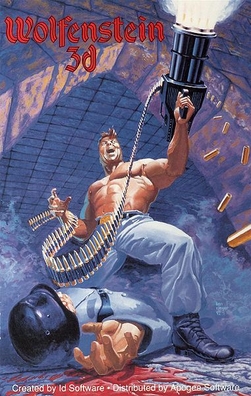
Wolfenstein 3D is a first-person shooter video game developed by id Software and published by Apogee Software and FormGen. Originally released on May 5, 1992, for DOS, it was inspired by the 1981 Muse Software video game Castle Wolfenstein, and is the third installment in the Wolfenstein series. In Wolfenstein 3D, the player assumes the role of Allied spy William "B.J." Blazkowicz during World War II as he escapes from the Nazi German prison Castle Wolfenstein and carries out a series of crucial missions against the Nazis. The player traverses each of the game's levels to find an elevator to the next level or kill a final boss, fighting Nazi soldiers, dogs, and other enemies with a knife and a variety of guns.

Doom II, also known as Doom II: Hell on Earth, is a first-person shooter game in the Doom franchise developed by id Software. It was released for MS-DOS in 1994 and Macintosh in 1995. Unlike the original Doom, which was initially only available through shareware and mail order, Doom II was sold in stores.
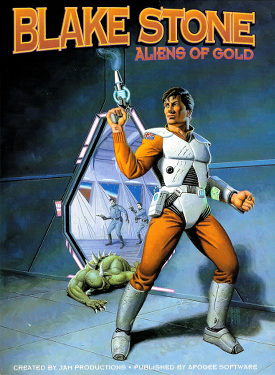
Blake Stone: Aliens of Gold is a first-person shooter for DOS created by JAM Productions and published by Apogee Software on December 5, 1993. The following year, a sequel called Blake Stone: Planet Strike was released, which continues where Aliens of Gold leaves off. Some copies of the game provided a Command Control Gravis Gamepad.

Crystal Caves is a side-scrolling platform game developed and published by Apogee Software for IBM PC compatibles. The game is divided into three episodes with the first distributed as shareware and the other two available for purchase. Designer Frank Maddin said the method worked "pretty well" for the time. Crystal Caves was inspired by the 1982 Atari 8-bit family game Miner 2049er.

Mystic Towers is an isometric platform game developed by Animation F/X, and published in 1994 by Manaccom domestically and Apogee Software internationally. Originally exclusive to MS-DOS compatible operating systems, it was re-released on Steam in 2015 with Microsoft Windows and Mac OS support. It stars Baron Baldric, an old wizard with a magic staff and an array of amusing mannerisms, who must quest through twelve towers and rid them of monsters. Mystic Towers is a sequel to Baron Baldric: A Grave Adventure, a platform game in which Baron Baldric battled an evil sorcerer ancestor.
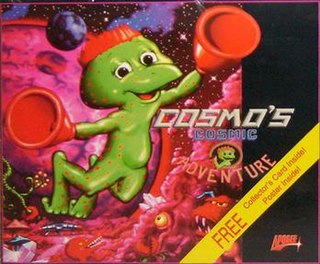
Cosmo's Cosmic Adventure: Forbidden Planet is a video game programmed by Todd Replogle and published by Apogee Software. It is a two-dimensional side-scrolling platform game. The game was released in mid March 1992 for MS-DOS compatible systems.

Duke Nukem is a 1991 platform game developed and published by Apogee Software for MS-DOS. The 2D, multidirectional scrolling game follows the adventures of fictional character Duke Nukem across three episodes of ten levels each. The game's first episode was distributed as shareware. The name was briefly changed to Duke Nukum to avoid trademark issues.
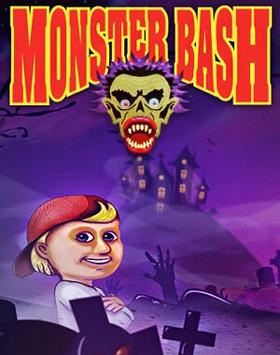
Monster Bash is a side-scrolling platform game developed and published by Apogee Software on 9 April 1993 for DOS. The game features 16-color EGA graphics and IMF AdLib compatible music. It was developed by Frank Maddin and Gerald Lindsly.

Raptor: Call of the Shadows is a vertically scrolling shooter developed by Cygnus Studios and published by Apogee Software. Its working title was "Mercenary 2029". It was released on April 1, 1994 for MS-DOS compatible systems. The first episode of the game, "Bravo Sector", was distributed as shareware. The other two episodes were sold commercially.
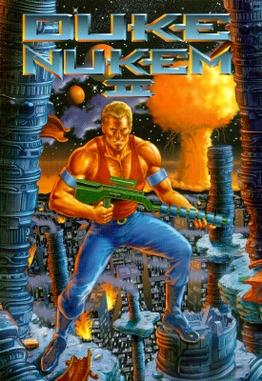
Duke Nukem II is a 1993 platform game developed and published by Apogee Software. The game consists of four episodes, the first available as shareware. It is the follow-up to 1991's Duke Nukem, and followed by Duke Nukem 3D in 1996. Todd Replogle was the primary designer of all three games.
Word Rescue is an educational platform DOS game written by Karen Crowther (Chun) of Redwood Games and released by Apogee Software in March 1992. It was re-released in 2015 for Steam with support for Windows and Mac OS. The game can also allow the player interact with a pair of Stereoscopic Vision Glasses.

Bio Menace is a 1993 game developed and published by Apogee Software for MS-DOS. A 2D multidirectional scrolling platform game, it was built on a licensed version of id Software's Commander Keen game engine. Apart from the engine and music, all in-game content was created by the game's designer, Jim Norwood. In 2014, the game was re-released on Steam, and in 2015 on GOG.com with support for Microsoft Windows, macOS, and Linux.
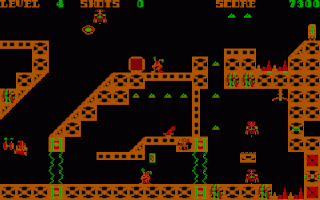
Monuments of Mars is a third-person puzzle-platform game developed by Scenario Software for MS-DOS and compatible systems. It was published by Apogee Software. The game consists of four 20-level episodes, the first episode being shareware, the rest being commercial software. It is similar to the games Arctic Adventure and Pharaoh's Tomb but uses an unrelated engine.
Secret Agent is a side-scrolling platform game developed and published by Apogee Software. The first episode is shareware, while the remaining two are sold directly by the publisher. Secret Agent uses the same game engine as the earlier Crystal Caves.

Boppin' is a puzzle-oriented video game created by Jennifer Diane Reitz in 1991, developed under the company name Accursed Toys and published by Karmasoft for the Amiga computer. Around that time Karmasoft held a level design contest. The game sold poorly with 284 copies, so Jennifer got it republished by Apogee Software with up to 256 colors on screen. Due to mature content containing blood and seppuku, Apogee included a disclaimer in the manual that the game contained potentially offensive imagery, as well as part of a manifesto from Accursed Toys stating that their games were produced for an audience of adult gamers who are mostly 25 and older.

Major Stryker is a 2D vertically scrolling shooter video game written for DOS by Apogee Software. Its working title was "Strike Force" and was released in January 1993. It consists of three episodes, with the first episode distributed as shareware, and the rest available commercially. The three episodes are set on a Lava Planet, an Arctic Planet and a Desert Planet. The game was re-released as freeware on March 14, 2006, and on Steam with support for Microsoft Windows and macOS in 2014.

Arctic Adventure is a platform game written for DOS, published by Apogee Software. It is the sequel to Pharaoh's Tomb. The protagonist, Nevada Smith, is an archaeologist searching for a Viking treasure in the Arctic. It was re-released on Steam in 2015 with support for Windows and macOS.

Star Trek: 25th Anniversary is a 1992 Game Boy video game developed by Visual Concepts and published by Ultra, based upon the Star Trek universe. The game chronicles a mission of James T. Kirk and his crew of the USS Enterprise. Despite having the same name, the Game Boy version is not a port of the NES game or computer versions, and is in fact a completely different game. It was succeeded by Star Trek: The Next Generation for Game Boy, developed and published by Absolute Entertainment the following year.

















